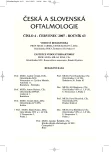Clinical Results of the Aphakia Correction by Means of Secondary Implantation of the Iris-Fixated Anterior Chamber Intraocular Lens
Klinické výsledky korekce afakie sekundární implantací na duhovku fixované předněkomorové čočky
Autoři referují o výsledcích sekundární implantace předněkomorové nitrooční čočky (PKIOL) Artisan® Aphakia. Tyto speciálně konstruované iris claw čočky fixované na duhovku pro korekci afakie jsme na Oční klinice v Hradci Králové implantovali v 51 případech (51 očí, 48 pacientů) v období od srpna 2002 do května 2005. Nejčastější indikací bylo ve 33 % předchozí trauma s poškozením čočky a následnou pooperační afakií. Druhou nejčastější příčinou použití PKIOL byla ve 29 % nepřítomnost čočky po operacích zadního segmentu pro amoci sítnice. V 18 % vznikla afakie jako následek komplikované intrakapsulární nebo extrakapsulární extrakce čočky. Dalšími indikacemi v souboru (20 %) s implantovanou PKIOL jsou pacienti se subluxovanou vlastní čočkou u Marfanova syndromu, po operaci zadního segmentu pro hemoftalmus s primární extrakcí katarakty bez implantace IOL, po luxaci umělé nitrooční čočky nebo čočkových hmot jako primární komplikaci po operaci katarakty.
Průměrný věk pacientů v době operace byl 59 let (v rozmezí od 8 do 86 let). Největší zastoupení měli muži v 70,6 %. V souboru bylo jedno dítě.
Před operací byla průměrná sférická refrakce +9,8 D ± 2,2 D ( rozmezí od 3 do 15 D), průměrná nekorigovaná zraková ostrost byla 0,05 ± 0,09, nejlépe korigovaná zraková ostrost byla 0,42 ± 0,29. Peroperačně nebyla zaznamenána žádná komplikace. Sledovanými parametry byla zraková ostrost, refrakce, poloha čočky, výskyt komplikací. Průměrná sledovací doba souboru byla 13,0 měsíců (rozmezí od 2 do 30).
Po operaci klesla průměrná sférická refrakce na -0,5 ± 1,62 D. Nekorigovaná zraková ostrost byla 0,27 ± 0,23 a nejlépe korigovaná zraková ostrost 0,43 ± 0,28. Z komplikací jsme zaznamenali ve třech případech sekundární glaukom, ve dvou případech krvácení do přední komory, v pěti případech iritidu a u jednoho oka subluxací čočky.
Klíčová slova:
afakie, sekundární implantace, Artisan Aphakia IOL, předněkomorová čočka
Authors:
V. Lorencová; P. Rozsíval; J. Urminský
Authors‘ workplace:
Oční klinika LFUK a FN, Hradec Králové, přednosta
prof. MUDr. P. Rozsíval, CSc.
Published in:
Čes. a slov. Oftal., 63, 2007, No. 4, p. 285-291
Overview
The authors refer about the results of the secondary implantation of the anterior chamber intraocular lens (AC IOL) Artisan® Aphakia. Those specially constructed iris claw lenses for aphakia correction, fixated on the iris, were implanted at the Department of Ophthalmology in Hradec Králové (Königgrätz, Czech Republic) during the period August 2002 – May 2005 in 51 cases (51 eyes, 48 patients). The most common indication (33 % of cases) was the previous trauma with lens damage and consequent postoperative aphakia. The second most common cause (in 29 %) of AC IOL use was the absence of the lens after the posterior segment surgery due to the retinal detachment. In 18 % of cases the aphakia was as a result of the complicated intracapsular or extracapsular cataract extraction. The other indications (20 %) for the AC IOL implantation are patients with subluxated their own (natural) lens in Marfan’s syndrome; after posterior segment surgery due to the intravitreal hemorrhage with primary cataract extraction without the IOL implantation; and after the luxation of the artificial intraocular lens or the lens remnants as a primary complication after the cataract surgery.
The average patients’ age at the time of surgery was 59 years (range, 8–86 years). Men participated in 70.6 % of cases. In the group of patients, there was one child as well. Before the surgery, the average spherical refractive error was +9.8 ± 2.2 diopters (D) (range, 3 – 15 D), the average uncorrected visual acuity was 0.05 ± 0.09; the best-corrected visual acuity was 0.42 ± 0.29. No complication during the surgeries was noticed. The followed parameters were visual acuity, refraction, AC IOL position, and occurrence of complications. The average followup period was 13.0 months (range, 2–30 months). After the surgery, the average spherical refraction decreased to -0.5 ± 1.62 D. The uncorrected visual acuity was 0.27 ± 0.23 and the best-corrected visual acuity was 0.43 ± 0.28. As complications, we noticed the secondary glaucoma in three cases, in two cases bleeding into the anterior chamber, in 5 cases iritis, and in one case the subluxation of the artificial lens.
Key words:
aphakia, secondary implantation, Artisan Aphakia IOL, anterior chamber lens, AC IOL
Labels
OphthalmologyArticle was published in
Czech and Slovak Ophthalmology

2007 Issue 4
Most read in this issue
- Macular Edema after an Uncomplicated Cataract Surgery
- Clinical Results of the Aphakia Correction by Means of Secondary Implantation of the Iris-Fixated Anterior Chamber Intraocular Lens
- Analysis of Movement Disorders Surgeries at the Department of Ophthalmology, the FNKV Hospital, Prague, Czech Republic, during the Ten-Years Period
- Evaluation of Glaucoma Progression by Means of HRT II Results
